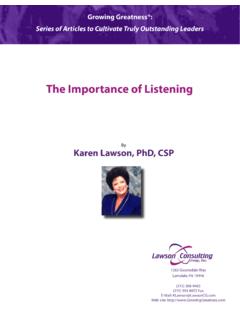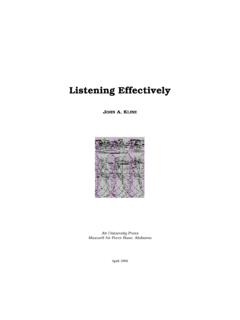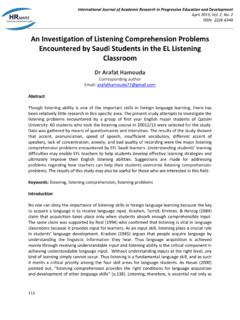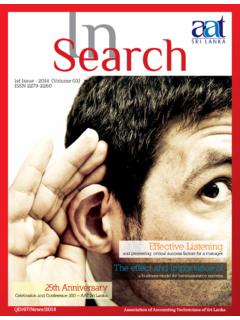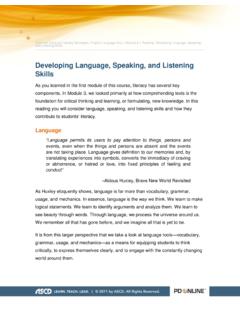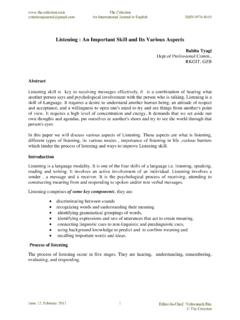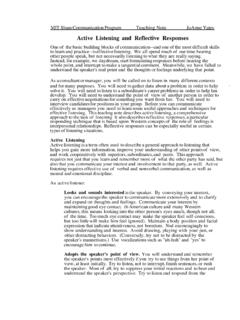Transcription of listening skills chapter final edit - Dr. Andrew Gottlieb ...
1 chapter : listening skills from Peer Counseling: skills and Perspectives Page 1 listening skills By Andrew Gottlieb , Peggy Smith, Peter Salovey, and Vincent D Andrea listening skills have broad applications. Many of you may find that you use them quite naturally. Good listening is about 50 percent of counseling, and it is also a useful tool with family, with friends, and at work. This book does not teach you how to become a therapist. listening is only part of helping, hut it is a crucial part.
2 A means of support, good listening helps people explore what they are thinking and feeling. Developing your skills may therefore help another person solve or clarify a problem. A word of caution about what good listening is not. It is not doing all the talking. It is not giving advice. It is not manipulating. It is not taking the responsibility for the other person s problem and its solution. The material in this chapter is based on the work of Alan Ivey (1978). We hope it will demystify the skills of active listening . These skills can be defined, taught, and learned.
3 You do not have to be superhuman to grasp them. In fact, you may find you have acquired one or more of the skills quite naturally, while you need to learn a few others. What is most important is a sincere desire to understand other people accurately and to he more aware of these skills skills that do facilitate interpersonal interactions. MINIMAL ATTENDING skills Minimal attending skills are the foundation that supports all the other skills . Sometimes called the art of listening with your mouth closed, this set of skills helps you be a more effective and empathetic listener.
4 Although we are not consciously aware of it much of the time, our body language is a critical part of how we relate and what we communicate. Of particular interest in this regard are eye contact and body posture. Good eye contact is important but complex. Different cultures and subcultures, even different individuals, have different standards for good eye contact. Be sensitive to another person s comfort; good eye contact says, I am with you but is not invasive. With practice, you will come to know when you are engaging in appropriate eye contact.
5 Just as eye contact varies from person to person or culture to culture, so does personal space. Being the right distance from another person is part of appropriate posture. In addition, leaning forward with an open, relaxed stance and without extraneous, distracting movement is part of an ideal posture. Once again, it is important to remember to be yourself and to use a posture that is comfortable for you. Another element of basic attending is verbal following. Verbal following differs from ordinary conversation, in which each person may be pursuing his or her own line of thought.
6 With verbal following, you let the other person determine the course of conversation while you simply nod, respond, or ask questions. Keep interruptions to a minimum and avoid topic jumping or changing the subject. Although it may be difficult at first, also avoid giving advice or judging the other person s motives, chapter : listening skills from Peer Counseling: skills and Perspectives Page 2 thoughts, and behavior. Avoid sharing your personal experiences or comparing notes.
7 Summary Minimal Attending 1. Eye Contact a. Look at the person most of the time. b. Communicate caring: I am with you, I m listening . 2. Body Posture a. Be comfortable, he relaxed, lean forward slightly. b. Be aware of personal distance. c. Avoid distracting gestures or fidgeting. 3. Facial Expressions a. Don t be a brick wall! b. Display appropriate empathy. 4. Following the Person s Lead a. Don t interrupt, don t change the subject. b. Listen, don t talk. c. Don t share experiences ( Oh, I ve been OPEN QUESTIONS This section concentrates on what we call the open invitation to talk.)
8 In it, we speak of open and closed questions. Open questions are questions that encourage a person to talk without feeling defensive. Closed questions are the kind asked by a census taker, a doctor, a lawyer, or a parent: in most cases, both parties in the conversation understand that very specific information is requested in very short answers. Examples of closed questions are: Did you do that last Monday? Is it true that there are three people living here? How long have you been here? Nothing is wrong with using a closed question if you need to and if the client is amenable.
9 However, such questions do tend to cut down communication; and if used unadvisedly, they can lead to frustration for the client. Especially frustrating are questions that begin with Have you tried or Do you think or What do you think, because such questions are really sneaky ways of giving advice or airing your opinion. Open questions, on the other hand, are phrased for the purpose of exploration. An open question allows the other person to direct the flow of conversation, to bring up more data, and to deal with it in more depth.
10 Open questions serve several functions: they can begin the interview, they may encourage the person to elaborate on a point or explore a point further; they may elicit specific examples to clarify what is being said; and they may allow the person to focus on his or her feelings. Open questions often do something further. They lead the conversation into a more personal, here-and-now, internal mode in which the client assumes responsibility for feelings and behavior. This contrasts with the anecdotal, external style of conversation, in which the client blames others for what is happening.
